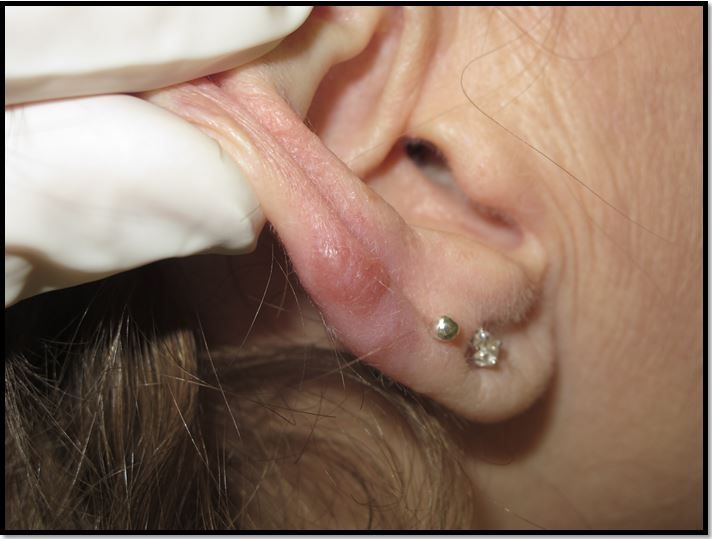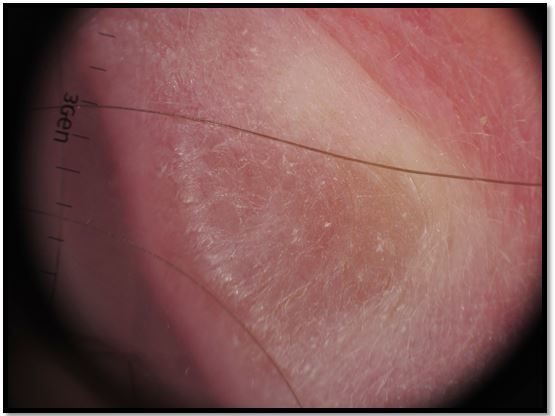- Clinical Technology
- Adult Immunization
- Hepatology
- Pediatric Immunization
- Screening
- Psychiatry
- Allergy
- Women's Health
- Cardiology
- Pediatrics
- Dermatology
- Endocrinology
- Pain Management
- Gastroenterology
- Infectious Disease
- Obesity Medicine
- Rheumatology
- Nephrology
- Neurology
- Pulmonology
Sarcoidosis: An Atypical Case
You might not think of sarcoidosis in this patient’s case, but that’s the point. Here: teaching points about a disease not to be missed.
Figure 1. (Please click to enlarge)

Figure 2. Dermoscopy of right helical rim shows yellow to orange globular-like area that suggests a granulomatous process such as cutaneous sarcoidosis.(6,7)

A 58-year-old Caucasian woman, a non-smoker, presented with an asymptomatic pink telangiectatic nodule with 2 adjacent smaller papules on her right helical rim (Figure 1, please click to enlarge). The lesion had grown over the past decade. A skin biopsy was obtained to rule out basal cell carcinoma.
The patient had a history of actinic keratoses on the face with insignificant facial erythema. She had no personal or family history of skin cancer. She had mild depression and anxiety, for which she had been taking sertraline and alprazolam.
Histologic evaluation of the shave biopsy revealed nodular aggregates of histiocytes with admixed lymphocytes in the superficial dermis. These were not naked granulomas typically seen in sarcoidosis; however, they were noncaseating. The overlying epidermis was unremarkable. Acid-fast bacilli, Fite, and GMS stains were negative for microorganisms, and no polarizable foreign material was seen.
The histologic differential diagnosis included granulomatous rosacea and sarcoidosis. However, the patient had no clinical evidence of rosacea, which made that diagnosis unlikely. Chest films showed bilateral hilar lymphadenopathy. No other signs of systemic involvement were present. Unfortunately, the patient never followed up for appropriate treatment.
Sarcoidosis: A quick review
Sarcoidosis, a systemic, noncaseating granulomatous disease of unknown etiology, is associated with genetic, immune, and environmental factors.1 There is a disproportionate number of African Americans with sarcoidosis in the United States; serologic studies have shown that certain class I and II HLA alleles on chromosome 6 may lead to increased susceptibility to sarcoidosis.2 Debate remains over the role of an infectious agent. In a genetically susceptible individual subsequently exposed to an extrinsic antigen, there may be activation of an inflammatory cascade that leads to granuloma formation.2
This case is atypical given the patient’s age and ethnicity: sarcoidosis typically presents in African American women in their third and fourth decades. In one-third of sarcoidosis cases, skin lesions are the initial manifestation. Cutaneous manifestations rarely occur in isolation: pulmonary involvement occurs in 90% to 95% of cases with cutaneous involvement.2 This patient did have stage I involvement (bilateral hilar lymphadenopathy); however, there was no pulmonary parenchymal (stage II) involvement, no infiltrates with fibrosis (stage III), and no honeycombing (stage IV).1
Patients with cutaneous involvement often experience systemic symptoms in the ensuing years; as such, all patients with cutaneous sarcoidosis should be evaluated for extracutaneous disease.2
The most common organ affected is the lung; all patients, including those who are asymptomatic, should receive a chest film and pulmonary function testing.3
All patients should also receive routine ocular examinations even if they are asymptomatic; the risk of permanent vision loss is too high.4 The most common development is anterior uveitis; optic neuritis is an emergency that must be treated immediately, since it can cause blindness.3 In addition, all patients should undergo evaluation for cardiac sarcoidosis; severity of disease can range from asymptomatic ECG changes to fatal arrhythmias.5 Other affected organs may include liver, spleen, and kidneys.2
Skin manifestations in sarcoidosis include specific lesions (noncaseating granulomas) and nonspecific nongranulomatous lesions that form as a result of reactive process, such as erythema multiforme and erythema nodosum. Variants of cutaneous sarcoidosis include lupus pernio, ichthyosiform, angiolupoid, and sarcoidal alopecia.2
Next: Diagnosis, Key Points, Bottom Line
Diagnosis
Sarcoidosis is a diagnosis of exclusion. Infectious conditions that should be excluded include tuberculosis, histoplasmosis, coccidioidomycosis, and syphilis. Angiotensin-converting enzyme (ACE) serum levels are increased in 60% of patients. ACE levels appear to correlate with granuloma formation. However, ACE levels are not good prognostic predictors for affected individuals.3
Key points
This case illustrates several teaching points about clinical diagnosis and treatment. This patient is a middle-aged Caucasian woman who presented with sarcoidosis with a unique cutaneous manifestation. The classic “textbook” case involves in a young African American woman with bilateral hilar lymphadenopathy on chest x-ray film. If one relies on pattern recognition of classic scenarios, a low clinical suspicion for sarcoidosis could lead to missed treatment. This patient is clearly beyond early progression of the disease and a thorough workup is needed. Secondly, she presents with a changing lesion on her right helical rim. Biopsy did not show typical naked granulomas without surrounding lymphocytes, usually seen in the early stages of the disease. The presence of lymphocytes indicates a later progression of the disease, which further emphasizes the need to always maintain clinical suspicion for this disease process.
Bottom line
It is critical to ascertain unusual presentations of diseases (both in terms of demographics and stage of progression) so that appropriate workup and treatment can be offered. Standard therapies for sarcoidosis of the skin include corticosteroids, antimalarials, tetracyclines, and methotrexate. Tumor necrosis factor-α inhibitors are used in recalcitrant cases.2
When faced with high clinical suspicion for cutaneous disease, primary care physicians play an important role in referring patients to dermatologists. Dermatologists often make the diagnosis of sarcoidosis, and may be the first physician to provide targeted care. Without early recognition and care, the ensuing systemic sarcoidosis can lead to high rates of morbidity.2
Disclosures:
The authors are affiliated with department of dermatology at SUNY Downstate College of Medicine in Brooklyn. Mr Anwar is a third-year medical student and Dr Lowenstein is Director of Clinical Research and Associate Professor.
References:
1. English JC III, Patel PJ, Greer KE. Sarcoidosis. J Am Acad Dermatol. 2001;44:725-743.
2. Haimovic A, Sanchez M, Judson MA, et al. Sarcoidosis: a comprehensive review and update for the dermatologist. Part I. J Am Acad Dermatol. 2012;66:e1-e18.
3. Haimovic A, Sanchez M, Judson MA, et al. Sarcoidosis: a comprehensive review and update for the dermatologist. Part II: extracutaneous disease. J Am Acad Dermatol. 2012;66:e1-e10.
4. Usui Y, Kaiser ED, See RF, et al. Update of ocular manifestations in sarcoidosis. Sarcoidosis Vasc Diffuse Lung Dis. 2002;19:167-175. http://europepmc.org/abstract/med/12405485.
5. Vignaux O. Cardiac sarcoidosis: spectrum of MRI features. Am J Roentgenol. 2005;184:249-254. http://www.ajronline.org/doi/full/10.2214/ajr.184.1.01840249]
6. Marchell RM, Judson MA. Chronic cutaneous lesions of sarcoidosis. Clin Dermatol. 2007;25:295-302.
7. Pellicano R, Tiodorovic-Zivkovic D, Gourhant JY, et al. Dermoscopy of cutaneous sarcoidosis. Dermatology. 2010;221:51-54.
